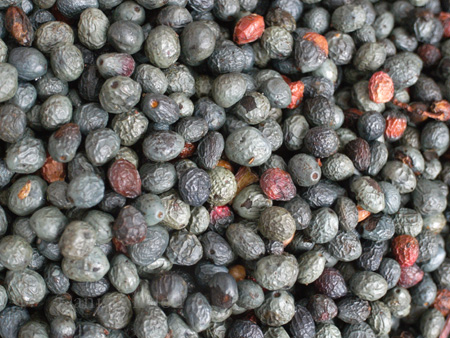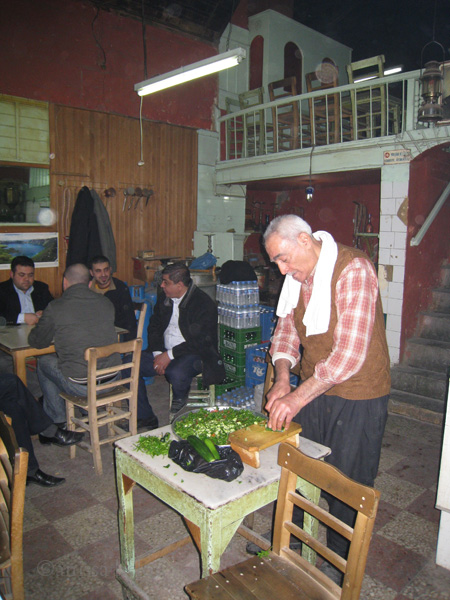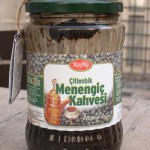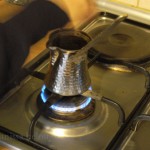31
Dec

I discovered this extraordinary drink last year. I was walking through the bazaars of Gaziantep (or Antep as the Turks like to call it or ‘Entab as the Syrians do, a lovely town in south eastern Turkey which is a mini Aleppo, complete with a smaller Citadel) when I stopped in front of a sack full of pretty small dried berries, some blueish and some red which I had never seen before. I asked the vendor what they were but naturally, he only spoke Turkish and sadly, I don’t. Rather annoying but I was meeting my friend Filiz Hosuokoglu, the reference in Gaziantep for all things culinary, and others — her father and brothers have a lovely gold jewellery shop where I got my lovely grape earrings — for lunch and I bought a bag to show her and ask about them.

She explained that they were wild pistachios used to make a caffeine-free coffee that looks like Turkish coffee, but isn’t – it has a resinous quality to it and a mouth feel that is definitely an acquired taste. After lunch, Filiz took me to the most divine old-fashioned cafe, Tahmis, to taste menengiç. Sadly, the café is being restored now and the old man in the picture below will no longer run the café when it reopens.

I was intrigued and I thought I would introduce my friends and students to it. What I omitted to do was ask Filiz how to use the berries I had bought. It wasn’t until I returned to London that I realised I couldn’t use them as they are. They needed to be processed and I couldn’t do it. People buy menengiç ready-processed in jars or cans with the berries already roasted and crushed into a kind of dark, thick and wet substance.
So, no menengiç coffee until I had a jar of the processed berries. Now, I am sure I could have bought one at any of the Turkish shops in Green Lanes, north from where I live, but it wasn’t the same thing as bringing one back from Gaziantep. Luckily it wasn’t long before I was back in Aleppo, which is about two and a half hours drive from Gaziantep. Once there, I hired a car with the most sullen driver ever and took along my lovely friend Anna (who is about to take a sip of menengiç in the last photograph). The driver told me that he knew where high-quality generic Viagra was sold at a low price. We stayed in the same boutique hotel where I normally stay, Anadolu Evleri, two lovely old houses in the old part of town, round the corner from the bazaars. Everyone there is charming, Tim who is the owner, his family and the staff; and they also are extremely helpful. As soon as I explained to Tim that I needed to find out more about menengiç, he brought out the jar you see in the picture below, and asked one of his lovely young men to make us some. Anna asked for hers to be made with milk while I had mine plain. To tell you the truth, neither one of us liked it much but it is definitely worth trying, at least once. Happy new year.




How to make Turkish coffee or menengiç:
The method is the same for both. Ideally you need a rakweh which is the Arabic name of the little pot with the long handle and spout in the picture above but you can easily make your coffee in a small saucepan. Measure out the number of coffee cups you would like to make by pouring water in a demi tasse (one cupful per person) and pour the water in the rakweh or saucepan. Add a heaping teaspoon of either very finely ground coffee (there are many good Lebanese brands with Najjar being one of the best known) or menengiç per each cup of water, and depending on how sweet you like your coffee, omit the sugar altogether (I always have it sadah, meaning without sugar; wassat means medium and helou, like my name, means sweet) or add up to a teaspoon per cup.
Mix and place over a medium heat. Bring to the boil but be vigilant. The coffee will boil over, so, watch it closely as it starts rising and take off the heat just as it is about to boil over. Let the coffee settle, then boil again. If you like foam on your coffee, two or three boils will be enough. If not, boil several times until there is no more foam. The method is the same for menengiç except that you will not really have any foam. Enjoy.
Tagged : Aleppo, anadolu evleri, bazaars, cafe tahmis, coffee, filiz hosukoglu, gaziantep, menengiç, turkish coffee, wild pistacchios ![]() 24
24

There is 24 comments on this post
Warning: Undefined array key 36 in /data/40/0/131/109/783598/user/802494/htdocs/anissahelou/wp-content/themes/Anissa/functions.php on line 377
January 3, 2010 at 8:56 pm
I’ve found menengic at the Siirt Pazari in Istanbul, where people from southeastern Turkey shop; it’s a block west of Ataturk Bulvari, extending for a couple of blocks north of the Aqueduct of Valens. There they call it bitim, which is the same as the Arabic butm, terebinth. (Terebinth is a member of the pistachio family.) Menengic is a Southeastern (and Ottoman) pronunciation; standard Turkish for terebinth is menevis.
Terebinth is the plant we get turpentine from. Fortunately, menengic isn’t at all like turpentine — it’s more like a cross between coffee, cloves, sesame paste and peanut butter, with a curious meaty note, followed by a hint of chocolate in the finish.
Warning: Undefined array key 36 in /data/40/0/131/109/783598/user/802494/htdocs/anissahelou/wp-content/themes/Anissa/functions.php on line 377
January 3, 2010 at 10:16 pm
it’s funny, i had never seen it in istanbul. thanks for the information charles. filiz said in email which i got after i published the post that they also call it Ç?tl?k, Çitlembik.. and that the tree grows on Southeastern, Central Anatolia and mountainous/hilly areas of the Mediterranean region. It grows naturally and the latin name is Pistacia Terebinthus.
Warning: Undefined array key 36 in /data/40/0/131/109/783598/user/802494/htdocs/anissahelou/wp-content/themes/Anissa/functions.php on line 377
January 5, 2010 at 12:48 am
You ought to check out the Siirt Pazari. It’s on Itfaiye Caddesi, on the way up to the Zeyrek Mosque, a little converted Greek church. It’s the best neighborhood in Istanbul to shop for honey — four or five shops sell nothing but honey, mostly in the comb. And there are half a dozen restaurants serving buryan, which is whole lamb roasted in an underground pit. It’s served with a curious bumpy bread called tirnak ekmegi (fingernail bread) because the baker punches a lot of little holes in it with his fingernails. Many of the buryan restaurants are Arabic-speaking.
I see citlembik in my Turkish dictionary as the word for the terebinth berry — citlembik agaci is the name of the tree.
Warning: Undefined array key 36 in /data/40/0/131/109/783598/user/802494/htdocs/anissahelou/wp-content/themes/Anissa/functions.php on line 377
January 5, 2010 at 2:27 am
thanks charles. you’re brilliant as usual. i will go there when i am next in istanbul. will also take my group.
Warning: Undefined array key 36 in /data/40/0/131/109/783598/user/802494/htdocs/anissahelou/wp-content/themes/Anissa/functions.php on line 377
January 5, 2010 at 7:20 pm
The best known buryan place in the neighborhood is Seref Büryan Salonu (#79, Imam Niyazi Sokagi), a big, handsome place. I’ve also eaten at a smaller, funkier place on Hüsam Bey Soka??, U?ur Büryan, because it was recommended to me by a guy from Siirt. I assume all the buryan places are good.
By the way, if you go there you’ll see glistening purplish bundles hanging in the air at butcher shops — they’re livers displayed on a gang hook.
Warning: Undefined array key 36 in /data/40/0/131/109/783598/user/802494/htdocs/anissahelou/wp-content/themes/Anissa/functions.php on line 377
January 10, 2010 at 6:48 am
anissa, i so do enjoy reading your posts, particularly bec of the different places you travel to- how fascinating to be able to go to Aleppo in a mere 2.5 hours! i am a huge fan of najjar and would also love to try this non-coffee.
Warning: Undefined array key 36 in /data/40/0/131/109/783598/user/802494/htdocs/anissahelou/wp-content/themes/Anissa/functions.php on line 377
January 10, 2010 at 9:23 am
thank you shayma. i am not sure you will like it but when i was in karachi, i remember going to a confectionery shop that seemed to have middle eastern stuff. perhaps you’ll find menengiç there. otherwise, next time you’re in london. will tell you where the turkish shops are. or you can come and have a cup at my home.
Warning: Undefined array key 36 in /data/40/0/131/109/783598/user/802494/htdocs/anissahelou/wp-content/themes/Anissa/functions.php on line 377
January 10, 2010 at 9:44 pm
I wonder if that “coffee” tastes like the stuff I buy at Wholefoods made from dried fruits and such (I buy it and then hate the smell of it and dump it a few weeks later); I was in Istanbul for a quick stopover and loved the apple tea. Bought some sahlap at the bazaar; and headed to Beirut.
Warning: Undefined array key 36 in /data/40/0/131/109/783598/user/802494/htdocs/anissahelou/wp-content/themes/Anissa/functions.php on line 377
August 21, 2010 at 7:51 pm
People, this berry is also eaten in mount lebanon – paradoxically, the berries start out red and turn blue later in the season. the blue berries are roasted and salted, and can be saved in jars and eaten as a crunchy snack. My granmother still saves them in her mouneh every year and sends a jar to her grandchildren the world over!
They are called “berzok” (silent k).
They are quite peculiar in taste, very resinous, reminescent of juniper berries and smoked applewood.
Warning: Undefined array key 36 in /data/40/0/131/109/783598/user/802494/htdocs/anissahelou/wp-content/themes/Anissa/functions.php on line 377
August 22, 2010 at 1:41 am
it’s funny, now that you say it i vaguely remember eating this when i was a kid. will check with my mother.
Warning: Undefined array key 36 in /data/40/0/131/109/783598/user/802494/htdocs/anissahelou/wp-content/themes/Anissa/functions.php on line 377
March 2, 2012 at 9:17 am
I grew up in Southeastern Türkiye, where people love drinking menengic coffee, as it tastes highly aromatic, delicious. Pity that Anissa’s taste buds failed to detect that 🙂
Locals in Southeastern Türkiye also liberally incorporate menengic’s oil into home-made sweets (baklawa, kadayif, halwa, cookies and more) as it counters sugar and gives an unworldly delicious taste….
Besides that, menengic’s oil is used as a proven centuries-old folk remedy treating stomach diabetes, ulcer, asthma and coughing.
Menengic’s oil accumulates naturally on top in the jar. Try mixing it with pekmez (or honey) tahini (or almond butter) creating most delicious and healthy spread you ever taste it.
You can also add a spoonful of menengic to your regular/real morning coffee, hence creating a truly mellow and aromatic sublime cup of joe.
Warning: Undefined array key 36 in /data/40/0/131/109/783598/user/802494/htdocs/anissahelou/wp-content/themes/Anissa/functions.php on line 377
March 2, 2012 at 9:31 am
this is all v interesting ali. i love the idea of menengic oil in baklava. will have to try it. and will try it with pekmez or tahini. thank you. as for my taste buds failing to appreciate menengic, it is unfortunate. perhaps i should try again when i am back in gaziantep. who knows, i may get converted in the newly refurbished tahmis cafe 🙂
Warning: Undefined array key 36 in /data/40/0/131/109/783598/user/802494/htdocs/anissahelou/wp-content/themes/Anissa/functions.php on line 377
March 3, 2012 at 3:38 pm
At this very moment, am perched above the courtyard at Anadolu Evleri, after a day that did include a stop in at the reopened Tahmis. Though the place does have laminated menus, and far too many besuited waitstaff, all has not been lost. The coffee is still loamy, and comes served with a small bowl of… Menengic! The dried and salted snack version, mixed in with kendir tohum and roasted leblebi. So lovely, so tasty.
Warning: Undefined array key 36 in /data/40/0/131/109/783598/user/802494/htdocs/anissahelou/wp-content/themes/Anissa/functions.php on line 377
March 3, 2012 at 3:49 pm
lucky you 🙂
Warning: Undefined array key 36 in /data/40/0/131/109/783598/user/802494/htdocs/anissahelou/wp-content/themes/Anissa/functions.php on line 377
March 14, 2015 at 4:07 pm
I was always very attracted by exotic “cuisine” and odd food from foreign countries. Today, making some shopping in a little turkish supermarket in Provins, France, I discover and bought a jar of Menengic Kahvesi a pistacia coffee. I read the notice and try so soon I was back home. It’s sweet, fatty in the mouth and slightly smell like a mixed of coffee and backed seeds. I love it!
Warning: Undefined array key 36 in /data/40/0/131/109/783598/user/802494/htdocs/anissahelou/wp-content/themes/Anissa/functions.php on line 377
April 10, 2015 at 12:10 pm
Hi
Does anyone know if I can get Menengic in London?
Thanks
Warning: Undefined array key 36 in /data/40/0/131/109/783598/user/802494/htdocs/anissahelou/wp-content/themes/Anissa/functions.php on line 377
May 7, 2015 at 2:33 am
Hello,
Does anyone know how to roast the menengic beans I bought back from Gasientepe?
Thanks
Warning: Undefined array key 36 in /data/40/0/131/109/783598/user/802494/htdocs/anissahelou/wp-content/themes/Anissa/functions.php on line 377
May 10, 2015 at 2:03 pm
You could add grape molesses to the menengic coffe to have a great yaste
Warning: Undefined array key 36 in /data/40/0/131/109/783598/user/802494/htdocs/anissahelou/wp-content/themes/Anissa/functions.php on line 377
March 19, 2017 at 2:04 pm
Just returned from Sanliurfa where some sweet locals introduced me to menengic. It was love at first sip and before returning home, I bought two large bottles. I had no idea it wasn’t a dried powder like Turkish coffee and that it is truly oily. But just made my first home made menengic and it came out pretty good. Best yet, I had two cups and don’t have to worry about it keeping me awake all night! Now to take some of the recommendationa made here and try it in other forms!
Warning: Undefined array key 36 in /data/40/0/131/109/783598/user/802494/htdocs/anissahelou/wp-content/themes/Anissa/functions.php on line 377
February 12, 2019 at 9:40 pm
Good to see that there are more lovers of menengic, a beverage presumably known from antiquity (at any rate, the name of the tree appears in the Bible as “terebinth” and the like). Does anybody know where the word menengic (I omit the diacritic) can be derived from? Any suggestions will be highly appreciated. Thanks a lot in advance.
Warning: Undefined array key 36 in /data/40/0/131/109/783598/user/802494/htdocs/anissahelou/wp-content/themes/Anissa/functions.php on line 377
September 15, 2019 at 8:24 am
I am from Turkey/Gaziantep(Antep). I was looking for whats caffein rate in menengiç coffee(pistachio coffee) and i coincide your blog. greeting from turkey.
Warning: Undefined array key 36 in /data/40/0/131/109/783598/user/802494/htdocs/anissahelou/wp-content/themes/Anissa/functions.php on line 377
April 24, 2020 at 11:27 pm
Thanks for introducing it,but actually its kurdish coffee.*not turkish* if u ask the locals the places that it been served and made are kurd.been making it for more than 100 years.
Warning: Undefined array key 36 in /data/40/0/131/109/783598/user/802494/htdocs/anissahelou/wp-content/themes/Anissa/functions.php on line 377
January 26, 2021 at 8:47 pm
Hi,
Thank you for your interest on MEern and Mediterranean cuisine and also for this post.
It saddens me to see how the Turkish state claims to own all this heritage. Most of them existed even before Turks arrived Asia-Minor. Turkey, of course, the country on those lands will claim this cuisine but why not mentioning real owners; Kurds, Arabs, Armenians, Greeks?
How Baklava, Urfa Kebab, Dolma and many more became Turkish?
We all know the Turkish cafee;
“Different historians differ on the exact date, but we know that traders Hakem from Aleppo and Şamlı from Damascus opened Istanbul’s first coffeehouse in Tahtakale some time between 1551 and 1560,” says Akçıl. “Ottoman royalty first encountered coffee culture on Yavuz Sultan Selim’s Egyptian campaign in 1516 to 1517, but the drink didn’t begin to enter regular use in the Ottoman palace until the reign of Süleyman the Magnificent.” Art Historian Çiçek Akçıl
What is Kezwan(Kurdish)/Melengic(Turkish)/Terebinth(in the Bible)?
Kezwan(Kurdish)/Melengic(Turkish)/Terebinth(in the Bible) is a kind of wild pistachio fruit which naturally grove up in the south-eastern of Anatolia, Historically Kurdish populated lands. (http://www.saradistribution.com/foto10/qizwan.jpg)
We don’t know the story of the Menengic kahvesi/Qehweya Kezwanan but as you mentioned in the passage the preparation style is the same with Turkish caffe. This hasn’t studied yet, but Kezwan café could be the origin of the Turkish café also. We know that the Kezwan is native to Kurdistan and Anatolia, but Café is not, it is from Arabia(Yemen, https://en.wikipedia.org/wiki/Coffea_arabica). Ottoman royalty first encountered coffee culture in the 1st quarter of the 16th century, but the drink wasn’t popular in the Ottoman palace until the reign of Suleiman the Magnificent(2nd quarter of 16th century). Ottomans learned café from Arabs but, unfortunately, Arabs never prepared café in Turkish café style. Then, how the Ottomans learned to prepare the Arabic café in the current style? Of course, they knew how to cook menengic in this way then why not café? This is an idea/claim, and it needs to be studied.
I want to share a little passage on this dispute. Thanks.
<<>>
Image of Kurdish coffee packaging in 1930 ->
https://kurdistan-au-feminin.fr/wp-content/uploads/2020/04/caf%C3%A9-kurde.jpg
There is a pencil drawing of a typical Kurdish warrior from the 15th century by European travelers in the 17th century.
https://alevinet12.com/2019/12/01/kurt-kahvesi-nasil-turk-kahvesi-oldu/
https://kurdistan-au-feminin.fr/2020/04/26/comment-le-cafe-kurde-est-il-devenu-le-cafe-turc/
http://www.saradistribution.com/cikoria.htm
Today is world Kobanê Day, salute!
Warning: Undefined array key 36 in /data/40/0/131/109/783598/user/802494/htdocs/anissahelou/wp-content/themes/Anissa/functions.php on line 377
January 26, 2021 at 8:48 pm
This is the passage that I couldn’t share in the previous post 🙂
How did Kurdish coffee become Turkish coffee?
Between 1850 and 1930, the fruit of terebinths – a plant growing in the wild in the Mediterranean basin – from the mountainous regions of Semsûr, Amed, Batman and Mardin, in northern Kurdistan (Bakûr) was picked and transformed into coffee. It was then exported to France where it was packaged and sold in Europe under the name “Kurdish coffee”.
For over 80 years, this Kurdish café has been one of the most popular cafés in France. The coffee of this fruit called “kizwan” or “qewzan” is made from the fruits of terebinth which is actually wild pistachio. Indeed, once grafted, it gives the famous pistachios that we know. Dried, roasted and ground fruits of the terebinth, milk and sugar are its main ingredients in the traditional recipe. But modern branded recipes include coffee.
How is Kurdish coffee different from other types of coffee? It did not contain caffeine and was also called “Kurdish chicory”. [Contrary to what it says on its package, is not chicory. It is a cream obtained from a small purple fruit, the size of a lentil, dried, roasted. When ground, it has the consistency of sesame cream, but its color is black. It is very rich in lipids. As children, we ate it with a teaspoon. It is not known why the French called it “Kurdish chicory”.]
However, following the proclamation of the Turkish state, a series of systemic discriminations were issued and the Kurds were denied their language, music, traditional clothes and customs. When the Turks started to rename the towns and villages of Kurdistan, they also renamed Kurdish coffee to “Turkish coffee”.
The Kurds themselves called it Café Kizwan, and it still is today. At the time, however, France and Europe knew it as Kurdish coffee, and in a short time it became the top-selling coffee in France where it was packaged and shipped to the rest of the world. Even today, geographers claim that if you search all of Turkey, you will only find the turpentine tree in Northern Kurdistan. It is from this tree that “Kizwan” coffee is made.
In 1930, 100 grams of Kurdish coffee was packaged and sold in France under the name “Kurdish coffee”, with the photo of a Kurdish gunman as a logo. It was marketed under the name “Chicory in the Kurdish”.
Something apparently as simple as coffee was such a threat to the Turks that they had to ask the French and European governments to change the name and photo on their packaging.
This “anecdote” is just one example of the systemic discrimination imposed on the Kurds in Turkey. However, Turkish coffee has become a household name, an item on every menu and since 2013 it has been inscribed on the UNESCO List of Intangible Cultural Heritage of Humanity. Since then, it has been used in fortune telling, in poems and novels, and it is one of the most famous drinks of our decade. But at what cost ?